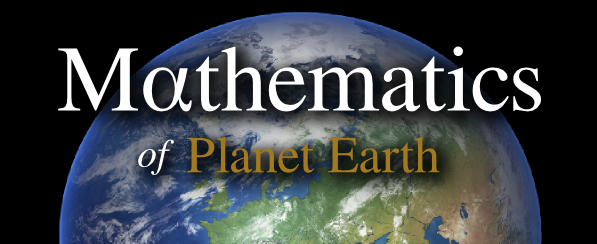Imogen Dell
Project Title:
Two-way Interactions of Troposphere and Stratosphere via Radiation, Reaction and Breakdown of Rossby Waves
Project Details:
Weather and climate are fundamentally underpinned by complex (hydrodynamical, chemical and radiative) processes taking place in the troposphere and stratosphere. The troposphere is extremely active, and there a variety of atmospheric waves are generated through different mechanisms including topographic forcing, heat sources and shear instabilities. These waves propagate upward to influence the stratosphere, which is otherwise in a state of chemical and radiative equilibrium. It is now recognized that understanding and accounting for this coupling are crucial for improving weather and climate predictions). Among numerous mechanisms proposed, an interesting and important one is the mutualinteraction through the reflection of Rossby waves by the stratosphere. The aim of the present project is (a) to investigate first the key fundamental aspects in troposphere-stratosphere interactions, namely, generation, reflection and breakdown of Rossby waves as well as their back action on the troposphere, (b) to integrate these fundamental processes in a united framework, thereby constructing a self-consistent physics-based model for troposphere-stratosphere coupling, and (c) to diagnose how processes such as Rossby wave reflection and its interference with upwards radiation influence the predictability of the flows in stratosphere and troposphere. It should be stressed that although generation, reflection and breakdown of Rossby waves will each be focused upon and analysed, a sufficiently general mathematical framework will be adopted to accommodate all three, and eventually to describe simultaneous two-way troposphere-stratosphere interactions. The interactive boundary (or multi) layer approach, including nonlinear critical-layer theory, will be developed by employing matched asymptotic expansion and multiple-scale techniques, which are powerful mathematical tools for handling nonlinear multi-scale, multi-physics problems such as ours.
Supervisor:
Prof Xuesong Wu
Peter Shatwell
Project Title:
A process study of heat uptake by the global ocean
Project Details:
A compilation of hydrographic surveys over the 20th century and the recent development of the ARGO float program have revealed significant variability of the oceanic heat content in all basins. Some of these changes must be related to the heat-content increase in responseto the accumulation of CO2 and other long-lived greenhouse gases in the atmosphere, but some must also reflect fluctuations intrinsic to the coupled ocean-atmosphere-cryosphere system. Due to limited observations and the costly computing requirements to study deep ocean heat uptake, our understanding of these fluctuations is poor. The goal of this PhD project is to step back and conduct a process study of heat content change, or heat uptake, by different elements of the global ocean circulation: wind driven gyres (the global ocean), buoyancy-forced overturning circulation in a narrow basin (North Atlantic), and wind- and buoyancy-forced circulation in a channel geometry (Southern Ocean). The aim is to develop simple (linear) models of heat uptake i.e. models in which knowledge of the pre-industrial oceanic state allows for a prediction of heat uptake in response to anthropogenic forcing. This prediction will then be applied and compared to observations.
Supervisor:
Dr Arnaud Czaja
Benjamin Snowball
Project Title:
Atmosphere modelling with spectral methods on spherical triangles
Project Details:
The goal of this project is to investigate sparse spectral methods on triangulations of the sphere as an alternative to the spherical harmonics approach currently in use at the European Centre for Medium- range Weather Forecasts in their weather and climate model. The aim would be to preserve the predictive skill of the current approach whilst avoiding the parallel scalability bottleneck from the global spectral transform, which is expected to inhibit the future performance of the ECMWF model.
Supervisor:
Dr Sheehan Olver
Giulia Carigi
Project Title:
Ergodic properties and response theory for a stochastic multi-layer model of geophysical fluid dynamics.
Project Details:
In the Climate Sciences, there is enormous interest in understanding the long term average behaviour of the climate system. In the context of climate models, this behaviour is expressed intrinsically through concepts of ergodic theory of dynamical systems. As opposed to conceptual (low dimensional) climate models, we study a more realistic atmospheric and ocean model: the two-layer quasi-geostrophic (2LQG) model with the upper layer perturbed by additive noise. This model is popular in the geosciences, for instance to study the effects of a random wind forcing on the ocean. Yet it is less studied in mathematics, especially if the stochastic perturbation is acting only on one of the layers. In this case the noise is effectively spatially degenerate, posing a significant challenge to the analysis.
After showing the model well-posedness, we focus on its long time average behaviour and ergodic properties: existence and uniqueness of an invariant measure (ergodicity), exponential convergence of solutions laws to the invariant measure (exponential stability or spectral gap), differentiability or only Hölder continuity of the invariant measure with respect to system parameters (linear or fractional response). In particular response theory provides a mathematical framework in which climate change triggered by a change in external parameters or forcings can be investigated. Therefore, by studying the ergodic properties and response theory for models in geophysical fluid dynamics, we expect not only a better understanding of the dynamical effects of climate change in general but also whether statistical properties derived under current climate conditions, such as downscaling approaches or forecast quality assessments, will be valid under future climates.
Supervisor:
Dr Jochen Broecker
Birgit Sutzl
Project Title:
Quantifying heterogeneity and microclimates in urban
developments
Project Details:
The aim of this project is to gain fundamental insight into
the modelling of heterogeneity and the influence of vegetation on the air
quality, temperature and energy usage of cities, with particular interest in
effects and variations on the street level. Air pollution has been acknowledged as one of the current most pressing problems of greenhouse gas emissions, and therefore more and more governments and municipalities realise the need to drastically reduce emissions from traffic. At the same time, emerging technologies lead the way to more automatisation and self-regulation of traffic flows, freeing up significant areas of street space, that have been previously blocked by parking cars and road congestions. Persisting pressures for the urban environment (e.g. air pollution from domestic heating, urban heat island effects, vulnerability to flooding, well-being) and resource scarcity of growing cities rate this potential free space to be a valuable asset, which can be used to transform cities to be more sustainable and resilient. Increasing greenery is thereby widely regarded as a key strategy to tackle many of the
above challenges that cities face. However greenery can also trap pollutants, potentially making the air quality worse. Understanding and describing all the effects of urban vegetation is thus necessary for the correct application of this strategy. Key to understanding air quality in urban environments is an accurate description of the flow. as was demonstrated in a recent study of over 15 air quality models11. Here, LES models, which resolve the flow including a large portion of the turbulence, offer a decisive advantage. Furthermore, the LES model is able to resolve the flow, vegetation and buildings on resolutions much higher resolution (typically 1m resolution) than conventional NWP
simulations (typically O(1 km) resolution).
Supervisor:
Dr Maarten van Reeuwijk
Joseph Wallwork
Project Title:
Anisotropic mesh adaptive methods in ocean modelling
Project Details:
Mesh adaptivity centres around the manipulation of the
computational meshes used in solving differential equations in such a way that
refinement is made where the error in the solution is estimated to be
relatively large and coarsening is made where it is small. As such, it is
possible to optimise the quality of the solution obtained, within bounds on
mesh size enforced by computational constraints, thereby obtaining both an
accurate and efficiently-computed solution to the problem at hand. Efficiently
achieving an accurate solution is an important factor in various fields related
to the Mathematics of Planet Earth, including tracking the dispersal of oil
spills, storm surge modelling and the simulation of ring formations such as the
Agulhas current the South Atlantic.
Mesh adaption is traditionally achieved by either mesh
refinement (h-adaptivity) or mesh relocation (r-adaptivity), the two of which
have not yet been successfully coupled in such a way that they do not work in
conflict with one another. This PhD project will seek to combine the two
approaches to form a hybrid (hr) approach, allowing for both refinement and
relocation to be implemented together. Through exploring the avenues opened by
mesh adaptivity, there is plenty of scope for the advancement of computational
models in the Planet Earth related application areas listed, amongst many more.
Supervisor:
Prof Matthew David Piggott
Golo Wimmer
Project Title:
Compatible numerics for numerical weather prediction
Project Details:
Compatible nite element methods have been recently proposed
as a flexible discretisation for the dynamical core of weather and climate
models. This flexibility allows to use more general types of grids that avoid
the parallel computing scalability bottlenecks associated with the
latitude-longitude grid. They are currently being developed for a new dynamical
core at the Met Office, within the Gung Ho project. In this PhD project we
investigate conservation properties of these discretisations, and approximate
systems of equations that filter out sound waves, for example.
Supervisor:
Prof Colin Cotter
Erwin Luesink
Project Title:
On stochastic geophysical fluid dynamics
Project Details:
Weather and ocean prediction requires solving the equations
of fluid dynamics. However, our incomplete understanding of turbulence and
other subgridscale effects, the chaotic nature of these equations as well as
the changing climate are several factors that make solving these equations
incredibly difficult. By means of introducing stochastic transport noise
[Holm2015] in the equations of geophysical fluid dynamics we will try to
improve weather forecasting, but more importantly also provide a proper
estimate of the uncertainty in the forecasts.
Supervisor:
Prof Darryl D Holm
Ivis Kerama
Project Title:
Improved Approximate Bayesian Computation (ABC) for
inference of the likely effects of climate change on animal populations
Project Details:
Individual-based models (IBMs) are used to simulate the actions of individual animals as they interact with one another and the landscape in which they live. IBMs are also known as Agent Based Models, and have a history dating back to the 1940s. The first models were types of cellular automata, which dynamically model the states (e.g. black or white) of a grid of cells through the application of rules that act locally (e.g. the state of a cell at a particular time depends on the state of its neighbours at the previous time). Conway’s “Game of Life” is the most widely known example of such a system. Now, the term IBM is used for any model in which a global system is modelled through local interactions; these systems play a big role in “Complexity Science”. The study of such systems often focuses on whether useful global-scale emergent behaviour arises through modelling on the local-scale. However, this project is less focussed on the characteristics of the forward model, and more on solving the inverse problem of parameter estimation. When used in spatially-explicit landscapes IBMs can show how populations change in response to climate change or management actions. For instance, IBMs are being used to design strategies of conservation and of the exploitation of fisheries given the likely effects of climate change on fish species. Stochastic computer simulation models are often the only practical way of answering such questions relating to climate change and ecological management. However, due to their complexity, such models are difficult to calibrate and evaluate: there is an urgent need for improved methodology for performing these tasks, since existing methods are too slow, and not always accurate. This project aims to improve the best existing method: Approximate Bayesian Computation (ABC). ABC is currently being used at Reading for statistical inference in a diverse range of applications in ecology, evolution and more widely. Examples include models of mackerel in the North East Atlantic, elephants in Amboseli National Park in Kenya, and local butterfly populations. These projects are investigating the likely impact of climate change. Other projects are studying cockles in the Burry Inlet; the evolution of pathogens; social network analysis; and statistical physics. In most of these cases the challenges of parameter estimation and model comparison are both of importance, but implementation can prove computationally expensive. This project aims to improve ABC methods and to collaborate with model builders to help them in fitting models to data. Initial focus will be on IBMs developed for fisheries management by Cefas, part of the UK government, where predicting the likely effects of climate change is of central importance. ABC works by comparing model outputs with data and is particularly useful for statistical inference where the model is only available in the form of a computer simulator such as an IBM. Ideal Bayesian methods produce a multivariate posterior distribution over the parameters. This posterior distribution specifies the degree of support for different parameter vectors given the model, data and prior knowledge about the values the parameters are likely to take. Identifying the exact posterior is not always feasible, leading to the development of approximate Bayesian methods, such as ABC. ABC outputs a sample of parameter vectors, which constitute an approximation to the posterior distribution. This sample is found through intelligently searching through the space of possible parameters, finding parameters that yield simulation outputs similar to real data. Originally developed within population genetics, ABC is now widely used, with recent applications to, for example, range expansions, emerging infectious diseases, and forest dynamics. Despite its successes, there are situations in which most currently available ABC methodologies are not computationally feasible: in cases when either the parameter space.
Supervisor:
Dr Thomas Thorne
Tsz Yan Leung
Project Title:
The Role of Mesoscale Dynamics in Predictability
Project Details:
It is a well-accepted fact in dynamic meteorology that the
chaotic nature of atmospheric dynamics imposes an inherent finite limit of
predictability (the celebrated ‘butterfly effect’). The quantification of
forecast uncertainty is thus an important question. A mathematical theory
behind this fact was first treated rigorously by Lorenz (1969), who used a
perfect model to estimate the growth of initial errors. However, atmospheric
models cannot be perfect. Phenomena beyond the truncation scale have to be
parameterised, leading to unavoidable model errors in the forecasts. An
important class of such small-scale phenomena is convection. Increasing the
horizontal resolution to allow explicit convection may therefore change the
role of model error in the uncertainty of forecasts. The ultimate goal of the
project is to study error growth properties of such a convection-permitting
version of the ECMWF’s Integrated Forecasting System and compare them with the
lower-resolution, convection-parameterised runs. Implications for ensemble
forecasting will also be studied.
As an intermediate step, I am already involved in a
numerical investigation of the dependence of error growth behaviour on initial
and model errors in the context of the idealised turbulence model in my MRes
work. This helps develop understanding and provides insights into diagnostic
quantities of error growth in the full model. The PhD project shall then expand
on this by studying the relevant mathematical aspects (Lyapunov exponents,
closure theory and model attractors) and extend the conclusions to the ECMWF
model. The project is expected to help provide guidance on the importance of
representing initial and model errors of current numerical weather prediction
(NWP) ensembles at scales in the dissipation range (i.e. less than ~100 km),
and on how important it is to correctly model the background energy spectrum in
the atmosphere in order to realistically simulate error growth in NWP
ensembles.
Supervisor:
Prof Theodore Gordon Shepherd
Laura Mansfield
Project Title:
Model reduction using emulation for understanding and
predicting climate responses to different regional emission forcings
Project Details:
The overall global response of the atmosphere to different
forcings has been researched substantially, but global and regional responses
of region-specific emissions have not been studied in as much depth. Long-lived
pollutants (e.g. greenhouse gases (GHGs) such as CO2) become evenly spread over
the atmosphere and cause homogeneous forcing worldwide. In contrast,
short-lived pollutants, such as aerosols (e.g. sulphate, black carbon), and
hence their associated forcing, are distributed inhomogeneously. Short-lived
pollutants are important for decadal climate prediction as they have a strong
impact on climate on such time-scales, while their sustained emissions changes
can lead to implications for future peak temperatures under GHG mitigation
scenarios and how those scale for different regions of interest. The focus of
the majority of previous studies has been on the mid-latitudes where most of
the developed countries lie (e.g. Europe, U.S., China and East Asia). However,
anthropogenic emissions from the tropics are likely to also change
substantially in the near-future, due to the rapidly developing countries e.g.
in Africa, so more research in this area is needed to predict future global and
regional climate response to those changing forcings. Additionally, emissions
from fire activity in the tropics can simultaneously impact largescale climate
in ways that are largely unexplored. The primary aim of the project is to
reduce a complex, computationally demanding climate model down to a statistical
model which describes regional patterns in the climate response to regional
forcings. Secondly, investigations of the physical mechanisms that link
regional forcings with the global and regional responses will be pursued, such
as for example the interactions of forcings with internal large-scale climate
oscillations.
Supervisor:
Prof Sarah Louise Dance






